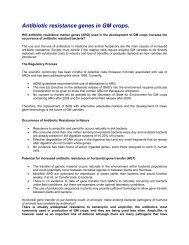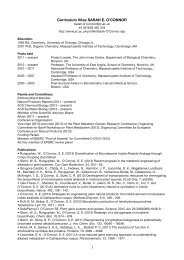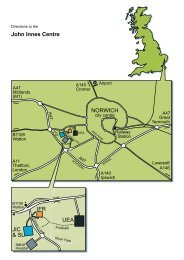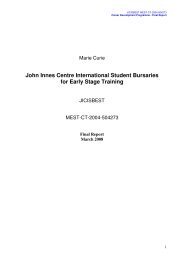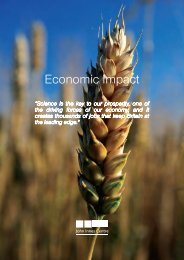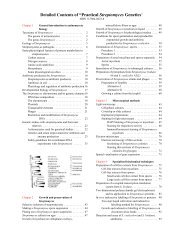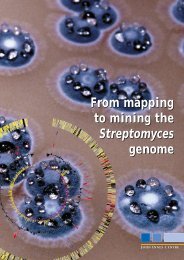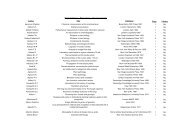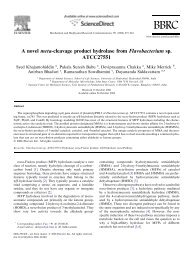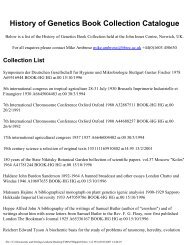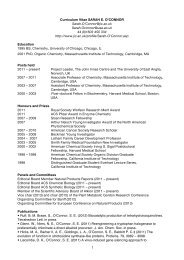1910s Timeline - John Innes Centre
1910s Timeline - John Innes Centre
1910s Timeline - John Innes Centre
Create successful ePaper yourself
Turn your PDF publications into a flip-book with our unique Google optimized e-Paper software.
1910 The <strong>John</strong> <strong>Innes</strong> Horticultural<br />
Institution opens<br />
Two acres of <strong>John</strong> <strong>Innes</strong>’ estate at<br />
Merton Park, his Manor House and<br />
conservatories, become the <strong>John</strong><br />
<strong>Innes</strong> Horticultural Institution.<br />
William Bateson’s directorship<br />
starts on 1 January 1910 and the<br />
Bateson family move into the<br />
Manor House in August. Most of<br />
Bateson’s researchers move from<br />
Cambridge with him making the<br />
<strong>John</strong> <strong>Innes</strong> Horticultural Institution<br />
the centre of British genetics. The<br />
Trustees purchase additional land<br />
and increase the original site to 6<br />
acres. Work begins in two small<br />
laboratories and four glasshouses.<br />
1910 William Bateson founds the<br />
Journal of Genetics with<br />
associates<br />
The Journal of Genetics, published<br />
by Cambridge University Press and<br />
edited by Bateson and R. C.<br />
Punnett, was launched as a<br />
quarterly periodical ‘for the<br />
publication of original research in<br />
Heredity, Variation and allied<br />
subjects’.<br />
Bateson used the Journal to<br />
promote his particular view of what<br />
the subject of genetics should<br />
include. In the early years this<br />
meant that most papers were<br />
reports of Mendelian hybridisation<br />
experiments and Bateson used his<br />
influence to actively discourage<br />
research on chromosome theory.<br />
However, in line with his view that<br />
genetics was the study of the<br />
‘physiology of descent’, the journal<br />
also included papers on the<br />
physiology of sex determination.<br />
The Journal was an important focus<br />
for British geneticists who faced<br />
powerful opposition from EW<br />
Macbride, Professor of Zoology at<br />
Imperial College, London, and a<br />
member of the governing body of<br />
<strong>John</strong> <strong>Innes</strong> (from 1913), and Karl<br />
Pearson, Professor of Applied<br />
Mathematics and Mechanics at<br />
University College. ’They stood at<br />
the entrance of the Royal Society<br />
like the leographs which guard the<br />
portals of a Burmese Buddhist<br />
temple’ (Crew, 1969).<br />
See:<br />
F.A. E. Crew, ‘Recollections of the<br />
early days of the genetical society’,<br />
pp. 9-15 in The Genetical Societythe<br />
first fifty years edited by <strong>John</strong><br />
Jinks. Edinburgh: Oliver and Boyd,<br />
1969.<br />
1910 Drosophila genetics begins<br />
Thomas Hunt Morgan and his<br />
group at Columbia University, New<br />
York select the fruit fly Drosophila<br />
melanogaster as a model organism<br />
to study genetics. Their<br />
experiments show that the flies can<br />
be easily kept in stoppered widenecked<br />
milk bottles and fed on<br />
slabs of fermenting banana.<br />
Drosophila has only four pairs of<br />
chromosomes that differ markedly<br />
in size and shape from each other.<br />
In the salivary glands of the larvae<br />
the chromosomes are relatively<br />
enormous. A mated pair produces<br />
scores of offspring in a 10-day<br />
cycle. All of these advantages make<br />
Drosophila good potential material<br />
for studying the effect of<br />
chromosomes on heredity.<br />
However, the wild flies lack clearly<br />
visible characteristics. It is not until<br />
Morgan’s team start to breed flies<br />
that the laboratory stocks of<br />
Drosophila develop well-marked<br />
and unusual characteristics. By<br />
selecting and breeding flies with<br />
visible mutations they turn<br />
Drosophila into a laboratory tool for<br />
studying inheritance. Morgan’s<br />
group includes Alfred Sturtevant,<br />
Hermann Muller and Calvin<br />
Bridges.<br />
Morgan publishes two papers on<br />
chromosomes: the first expresses<br />
his view that Mendelian factors<br />
could not possibly be carried by the<br />
chromosomes. Before this appears<br />
in print Morgan’s second paper is<br />
published; this provides convincing<br />
evidence that the factors for sexlinked<br />
characters are definitely<br />
carried in the X chromosome.<br />
Page 2 of 91



